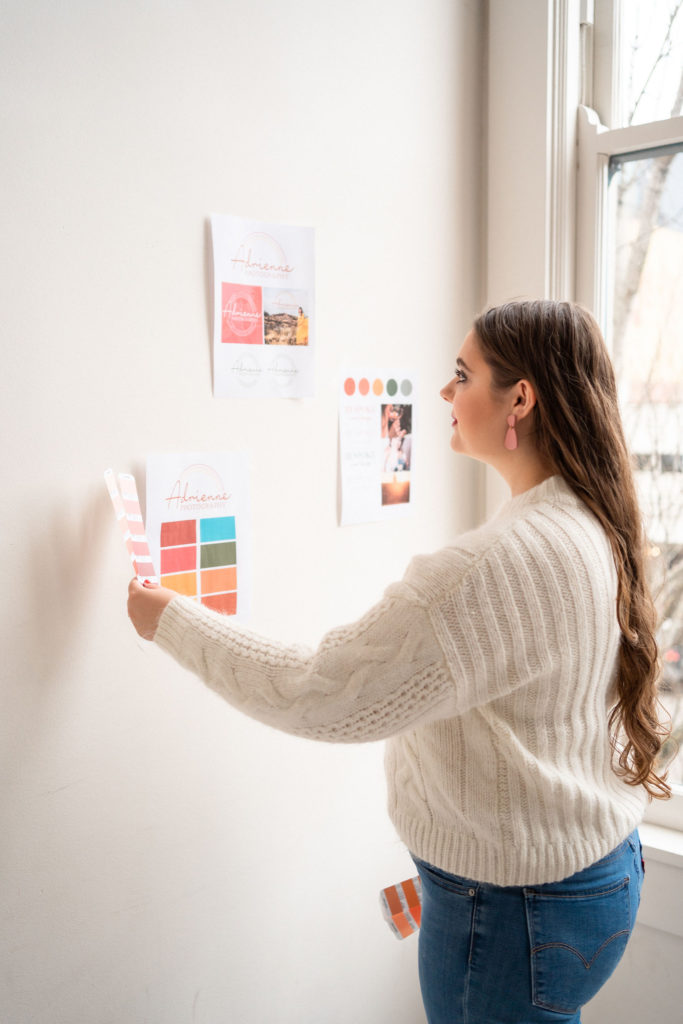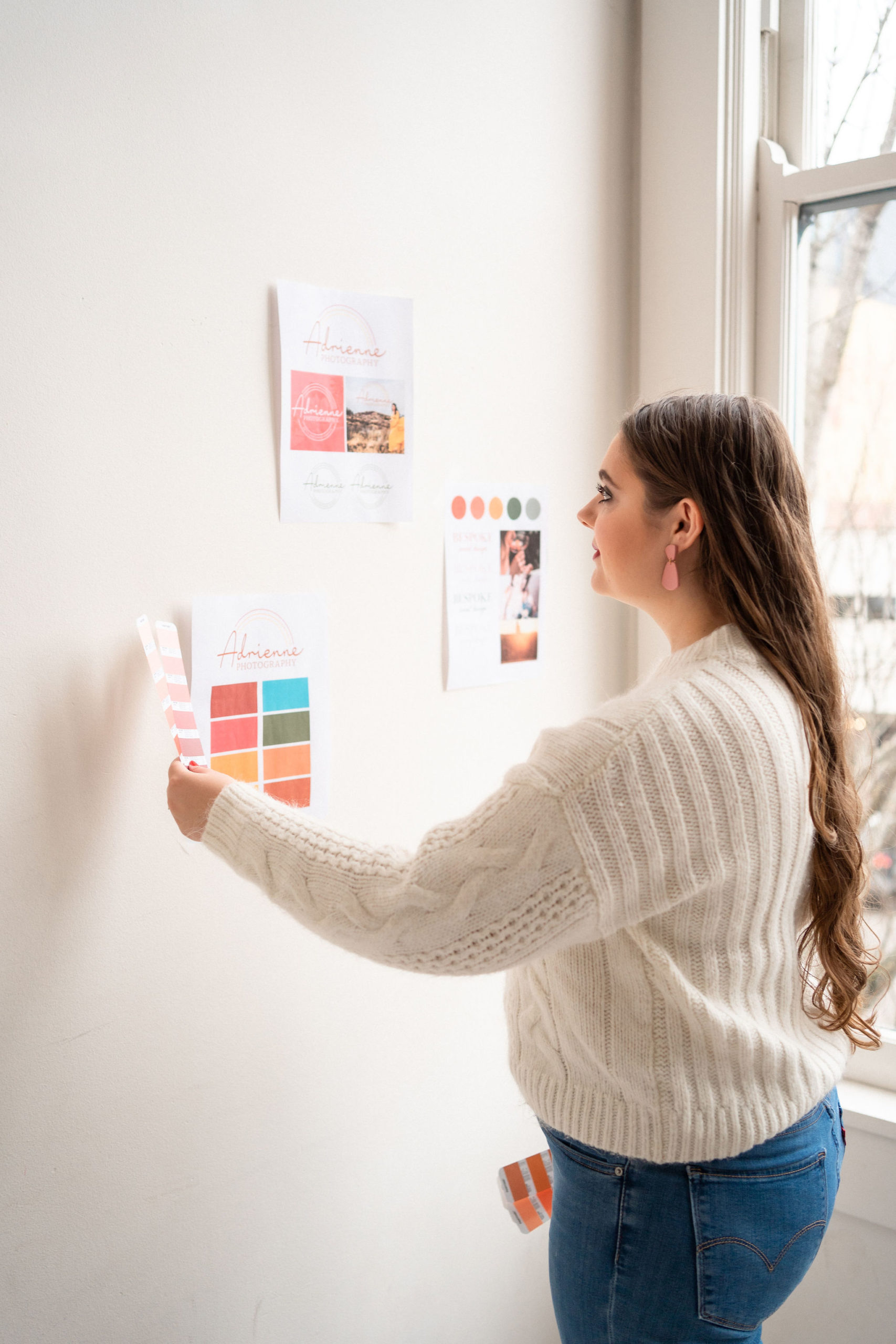Hi wedding friendors! (I have to give credit to my friend Tiffany Ruiz from Starr Weddings for that term. 😊)
I’m a big promoter of loving yourself no matter where you’re at in your journey, so we don’t do “new year, new you” around here. BUT, we do “new year, new brand. That is (in simple terms) what I get paid to do.
First, what’s a rebrand and what are the benefits of a rebrand?
WHAT A BRAND IS:
Think of it as the visual voice of your company and the way that your clients interact with you and your company. Brand identity includes logos, submarks (or secondary logos), color palettes, typography, patterns, icons, photography, videography, packaging, print, digital design, and more. It really varies based on what you need to get your business in front of the right people. But, we can save that information for another day.
WHAT A REBRAND IS:
- The short version: it’s a makeover of the visual voice of your company.
- The longer version: it’s a reshaping of how your ideal audience perceives your company, and how each visual component and communication from your brand is expressed. While it is a fun and pretty process, it’s also rooted in research and strategy.
While I love a good branding project, I come at all my design projects with strategy first. So, I want to make sure that branding makes sense for my clients, and is happening at the right time in your business.
7 Signs You’re Ready for Branding or a Rebrand
1. You’re clear on who your business is.
Not you, but your business. This is my number one piece of feedback for any business that’s looking to rebrand. If you’re 6 months into business and you’re not clear on your exact services and who your target audience is, I will kindly advise you to not invest in branding. There’s no clear rule for how long your business should be established, but you do need to be clear on your vision for your business. Luckily, this is something you can work on during the branding process, as long as you already have a sense of direction before starting. With in-depth strategy, a designer can walk you through the brand strategy process and ask you the right questions to get you thinking about your positioning.
2. You know exactly who you want to serve…
There’s a term called “client archetype” that you may have heard before. This is like an avatar of your dream client. You can be serving anyone right now, but if you’re not happy or fulfilled with that audience, let’s reexamine who you’d prefer to serve instead. For example, are you serving a lot of straight couples but you want to work with more LGBTQ couples? Are your current clients in their 20s and 30s, but maybe you want to serve clients who are in their 40s and older? There’s no right or wrong answer for this – you’re in your business for a reason and because you have a unique client to serve. And just like our identities, your client artchetype can be intersectional. You can also have multiple! Just try to make sure that your client archetypes are generally in the same niche or share similar mindsets, because it’s hard to talk with multiple very different groups at once. And, get very specific.
Here are two examples of client archetypes: A) Sam is 33 years old, works in tech as a developer, and is planning a wedding with her partner, Lily. Sam and Lily really love to travel, and they don’t want a huge wedding, so they decided to opt for a destination wedding, where just their immediate families and closest friends will be in attendance. They care a lot about quality content, so they’re looking for a photographer and a videographer who can travel with them to their wedding in Santorini. Along with this, they care about working with someone they can be friends with. They want to be able to sit down, enjoy a cup of coffee with their vendors, and they want you to stick around in their lives after the wedding has come and gone.
B) Hannah is 24 years old and has always dreamed of having a big wedding where all of her loved ones can be in attendance. That probably means 300+ people, because she has a big family. She met her partner, Daniel, in undergrad and is so excited to get married. She’s dreamt up every detail from the shade of terracotta that her bridesmaids will wear to the backdrop at their ceremony and how the peonies will look. While she’s very set on having the perfect day, she’s incredibly busy because both her and her partner are in medical school. Hannah’s parents want to be very involved in the wedding planning process and are paying for most of the costs. Hannah and Daniel will likely be hands off in the planning, so Hannah’s parents are looking for vendors who can work with them while still making Hannah’s dreams come to life.
3. …and you know you’re good at business, and have services/products that people want to pay for.
A rebrand is not necessarily a promise that you’ll make more money. While it’s very important and can help you make a lot more money in your business, it only works if your business works. So, you really need to make sure that you’re clear on the details of your business before investing. You need to have a clear understanding about your business problems and what is and isn’t working for you. For example, is your pricing set high enough to make a profit? Are you targeting the right clients? If you’re not, do you have a plan to target the right clients after your branding is done? What do your marketing efforts look like and are they working? Are your client processes simple, clear, and helpful to your clients, or are you losing business because something within your business isn’t making their experience amazing? I really, really want you to get clear on those questions before you spend any money on a designer. All businesses are constantly evolving, but once you know that your business is running efficiently, you can think about how to attract your dream audience to your business.
4. You’re changing your business name.
This one is pretty simple. If you change your business name (AND you have #1-3 checked off), it’s time for a rebrand. This is a great time to rethink your brand strategy, client archetypes, and general design look, especially if you’re switching from your own name to a business name, or vice versa.
5. You’re ready to activate your new branding.
The whole idea of getting branding is for your audience to see it, so there needs to be a plan in place to use your brand. Are you planning to redesign your website? What kind of printed content can help you with marketing (like business cards, flyers, or booklets)? Are you going to update your social media channels with your branding? This is actually more than just updating your profile picture and I don’t always recommend making your new profile picture a logo, but more on that later.
6. You’ve outgrown your current branding, or you’re embarrassed to share it.
Just like how we update our closets to represent who we are visually, you’re going to need to update your branding to represent who your company is. This doesn’t need to happen every year or even every 5-10 years, but it will likely change over time. If you’re consistently reaching the wrong clients or you cringe when you share your website URL with someone, it’s probably time for a rebrand. But, make sure you’ve thought through your strategy and client archetypes first. Life’s too short to have branding that doesn’t bring us joy and clients!
7. You’re ready for the financial and time investments.
Simply put, branding is expensive and it takes a lot of time. The time investment is one of the reasons why I don’t recommend that business owners DIY their branding, because it takes time to really make it excellent. That’s one of the reasons why even huge companies outsource their branding to experts. For a good designer and as a solopreneur or small business, you can expect to pay anywhere from $1,000 to $10,000+ for a branding package of varying sizes. Some packages will only include a logo, but there are many reasons why you should wait to invest until you can afford more than a logo. This has to do with brand consistency, quality, and length.
A typical branding project takes anywhere from 4-10 weeks. My own packages range from 4-6 weeks. It can take longer if you need extra deliverables like packaging, a website redesign, or marketing assets.
Myself and a lot of designers offer brand intensives, which can vary anywhere from 1 day to 2 weeks. These are quicker and typically more affordable solutions. However, the trade-off is that there’s less time for strategy, feedback, and a super detailed, customized design. These factors can be deal-breakers for some business owners, so be sure to understand what you’re paying for if you invest in either an intensive or full-length project.
There’s certainly more value in a full-length branding project and more time for strategy and thought, but brand intensives are a great solution for those who are ready for a rebrand but have a lower budget. But, day rates and week-long brand intensives will still typically cost you $1,000 or more, if you find a good designer who has experience and invests research and strategy into their work.
I know it can be really hard to invest money in your business, which is the reason why I suggest thinking about the first 6 factors before contacting a designer. You wouldn’t go to a car lot to spend thousands of dollars without understanding the type of car you need to get from Point A to Point B, so think of your branding in the same way. We designers LOVE to serve our clients and we love designing really pretty, strategic branding, but at the end of the day, we can only make it great if you come to us with a good foundation.
And remember, when you are ready to invest in branding, it’s a business expense, so it might be able to help you save money on taxes!
If you feel like your business aligns with these points, you can reach out to me via my contact form and we can set up a free call to figure out if we’d be a good fit to work together.

Leave a Reply Cancel reply
We respect your privacy.
Copyright Emily Foster Creative, LLC. 2021 - 2025. All rights reserved.
hello@emilyfostercreative.com
Brand photography by Lena Crocker Photo, Ciara Corin Photo, Moon & Honey Photography and Enliven Photography
Powered by podcasts and tea.
Designing out of Portland, Oregon for creatives around the world.

Be the first to comment